Effect of Alkaline and Hydrothermal Pretreatments in Sugars and Ethanol Production from Rice Husk Waste
Abstract
:1. Introduction
2. Materials and Methods
2.1. Rice Husk Characterization
2.2. Physicochemical Pretreatments Applied to Rice Husk
2.2.1. Alkaline Pretreatment
2.2.2. Hydrothermal Pretreatment
2.3. Enzymatic Hydrolysis of Cellulose and Hemicellulose
2.4. Alcoholic Fermentation
2.5. Analytical Methods
2.5.1. IR Spectroscopy (FTIR)
2.5.2. Quantification of Fermentable Sugars and Ethanol
3. Results and Discussion
3.1. Chemical Characterization of Rice Husk
3.2. Rice Husk Proximal Analysis
3.3. Determination of the Crystallinity of Rice
3.4. Chemical Characterization of Rice Husk Ashes
3.5. FTIR Analysis of Residue after Alkaline and Hydrothermal Pretreatments
3.6. Klason Lignin Quantification
3.7. Enzymatic Hydrolysis of Rice Husk with Hydrothermal and Alkaline Pretreatments
3.7.1. Partial Hydrolysis of Cellulose to Cellobiose
3.7.2. Total Enzymatic Hydrolysis of Cellulose
3.7.3. Hydrolysis of Hemicellulose to Xylose
3.8. Fermentation Alcoholic of Rice Husk Hydrolyzate with Alkaline and Hydrothermal Pretreatments
4. Conclusions
Author Contributions
Funding
Data Availability Statement
Conflicts of Interest
References
- Ahmed, B.; Aboudi, K.; Tyagi, V.K.; álvarez-Gallego, C.J.; Fernández-Güelfo, L.A.; Romero-García, L.I.; Kazmi, A.A. Improvement of Anaerobic Digestion of Lignocellulosic Biomass by Hydrothermal Pretreatment. Appl. Sci. 2019, 9, 3853. [Google Scholar] [CrossRef]
- Antunes, F.A.F.; Rajan, K.; Djioleu, A.; Rocha, T.M.; Brumano, L.P.; de Souza Melo, Y.C.; dos Santos, J.C.; Rosa, C.A.; Carrier, D.J.; da Silva, S.S. Sustainable Second-Generation Ethanol Production from Switchgrass Biomass via Co-Fermentation of Pentoses and Hexoses Using Novel Wild Yeasts. Bioenergy Res. 2022, 15, 1157–1168. [Google Scholar] [CrossRef]
- Barana, D.; Salanti, A.; Orlandi, M.; Ali, D.S.; Zoia, L. Biorefinery Process for the Simultaneous Recovery of Lignin, Hemicelluloses, Cellulose Nanocrystals and Silica from Rice Husk and Arundo Donax. Ind. Crops Prod. 2016, 86, 31–39. [Google Scholar] [CrossRef]
- Bárcena, A.; Samaniego, J.L.; Péres, W.; Alatorre., J.E. The Climate Emergency in Latin America and the Caribbean. The Path Ahead—Resignation or Action? ECLAC: Santiago, Chile, 2020; ISBN 9789211220322. [Google Scholar]
- Beidaghy Dizaji, H.; Zeng, T.; Hölzig, H.; Bauer, J.; Klöß, G.; Enke, D. Ash Transformation Mechanism during Combustion of Rice Husk and Rice Straw. Fuel 2022, 307, 121768. [Google Scholar] [CrossRef]
- Beukes, N.; Pletschke, B.I. Effect of Alkaline Pre-Treatment on Enzyme Synergy for Efficient Hemicellulose Hydrolysis in Sugarcane Bagasse. Bioresour. Technol. 2011, 102, 5207–5213. [Google Scholar] [CrossRef]
- Bianco, F.; Şenol, H.; Papirio, S. Enhanced Lignocellulosic Component Removal and Biomethane Potential from Chestnut Shell by a Combined Hydrothermal–Alkaline Pretreatment. Sci. Total Environ. 2021, 762, 144178. [Google Scholar] [CrossRef]
- Cao, J.W.; Deng, Q.; Gao, D.Y.; He, B.; Yin, S.J.; Qian, L.C.; Wang, J.K.; Wang, Q. A Novel Bifunctional Glucanase Exhibiting High Production of Glucose and Cellobiose from Rumen Bacterium. Int. J. Biol. Macromol. 2021, 173, 136–145. [Google Scholar] [CrossRef]
- Chio, C.; Sain, M.; Qin, W. Lignin Utilization: A Review of Lignin Depolymerization from Various Aspects. Renew. Sustain. Energy Rev. 2019, 107, 232–249. [Google Scholar] [CrossRef]
- Khare, S.K.; Pandey, A.; Larroche, C. Current Perspectives in Enzymatic Saccharification of Lignocellulosic Biomass. Biochem. Eng. J. 2015, 102, 38–44. [Google Scholar] [CrossRef]
- Dutta, S.K.; Chakraborty, S. Mixing Effects on the Kinetics and the Dynamics of Two-Phase Enzymatic Hydrolysis of Hemicellulose for Biofuel Production. Bioresour. Technol. 2018, 259, 276–285. [Google Scholar] [CrossRef]
- Ebrahimi, M.; Villaflores, O.B.; Ordono, E.E.; Caparanga, A.R. Effects of Acidified Aqueous Glycerol and Glycerol Carbonate Pretreatment of Rice Husk on the Enzymatic Digestibility, Structural Characteristics, and Bioethanol Production. Bioresour. Technol. 2017, 228, 264–271. [Google Scholar] [CrossRef]
- Alrumman, S.A. Enzymatic Saccharification and Fermentation of Cellulosic Date Palm Wastes to Glucose and Lactic Acid. Braz. J. Microbiol. 2016, 47, 110–119. [Google Scholar] [CrossRef]
- Phaiboonsilpa, N.; Chysirichote, T.; Champreda, V.; Laosiripojana, N. Fermentation of Xylose, Arabinose, Glucose, Their Mixtures and Sugarcane Bagasse Hydrolyzate by Yeast Pichia Stipitis for Ethanol Production. Energy Rep. 2020, 6, 710–713. [Google Scholar] [CrossRef]
- Sun, S.; Cao, X.; Sun, S.; Xu, F.; Song, X.; Sun, R.C.; Jones, G.L. Improving the Enzymatic Hydrolysis of Thermo-Mechanical Fiber from Eucalyptus urophylla by a Combination of Hydrothermal Pretreatment and Alkali Fractionation. Biotechnol. Biofuels 2014, 7, 116. [Google Scholar] [CrossRef]
- Sluiter, A.; Hames, B.; Ruiz, R.; Scarlata, C.; Sluiter, J.; Templeton, D.; Crocker, D. Determination of Structural Carbohydrates and Lignin in Biomass: Laboratory Analytical Procedure (LAP). Available online: https://www.nrel.gov/docs/gen/fy13/42618.pdf (accessed on 13 September 2024).
- Qiu, S.; Yadav, M.P.; Yin, L. Characterization and Functionalities Study of Hemicellulose and Cellulose Components Isolated from Sorghum Bran, Bagasse and Biomass. Food Chem 2017, 230, 225–233. [Google Scholar] [CrossRef]
- Iftikhar, M.; Asghar, A.; Ramzan, N.; Sajjadi, B.; Chen, W.Y. Biomass Densification: Effect of Cow Dung on the Physicochemical Properties of Wheat Straw and Rice Husk Based Biomass Pellets. Biomass Bioenergy 2019, 122, 1–16. [Google Scholar] [CrossRef]
- Jin, X.; Chen, X.; Shi, C.; Li, M.; Guan, Y.; Yu, C.Y.; Yamada, T.; Sacks, E.J.; Peng, J. Determination of Hemicellulose, Cellulose and Lignin Content Using Visible and near Infrared Spectroscopy in Miscanthus Sinensis. Bioresour. Technol. 2017, 241, 603–609. [Google Scholar] [CrossRef]
- Lu, J.; Liu, H.; Song, F.; Xia, F.; Huang, X.; Zhang, Z.; Cheng, Y.; Wang, H. Combining Hydrothermal-Alkaline/Oxygen Pretreatment of Reed with PEG 6,000-Assisted Enzyme Hydrolysis Promote Bioethanol Fermentation and Reduce Enzyme Loading. Ind. Crops Prod. 2020, 153, 112615. [Google Scholar] [CrossRef]
- Mishra, A.; Ghosh, S. Bioethanol Production from Various Lignocellulosic Feedstocks by a Novel “Fractional Hydrolysis” Technique with Di Ff Erent Inorganic Acids and Co-Culture Fermentation. Fuel 2019, 236, 544–553. [Google Scholar] [CrossRef]
- Ayala, H.; Kaiser, D.; Pavón, S.; Molina, E.; Siguenza, J.; Bertau, M.; Lapo, B. Valorization of Cocoa’s Mucilage Waste to Ethanol and Subsequent Direct Catalytic Conversion into Ethylene. J. Chem. Technol. Biotechnol. 2022, 97, 2171–2178. [Google Scholar] [CrossRef]
- Wang, L.; York, S.W.; Ingram, L.O.; Shanmugam, K.T. Simultaneous Fermentation of Biomass-Derived Sugars to Ethanol by a Co-Culture of an Engineered Escherichia Coli and Saccharomyces Cerevisiae. Bioresour. Technol. 2019, 273, 269–276. [Google Scholar] [CrossRef]
- De Oliveira, J.P.; Bruni, G.P.; Lima, K.O.; El Halal, S.L.M.; da Rosa, G.S.; Dias, A.R.G.; da Rosa Zavareze, E. Cellulose Fibers Extracted from Rice and Oat Husks and Their Application in Hydrogel. Food Chem. 2017, 221, 153–160. [Google Scholar] [CrossRef]
- Bhattacharjee, N.; Biswas, A.B. Catalytic Pyrolysis of Rice Husk with SnCl2, Al2O3.4SiO2.H2O, and MoS2 for Improving the Chemical Composition of Pyrolysis Oil and Gas. J. Indian Chem. Soc. 2022, 99, 100728. [Google Scholar] [CrossRef]
- Rashid, S.; Dutta, H. Characterization of Nanocellulose Extracted from Short, Medium and Long Grain Rice Husks. Ind. Crops Prod. 2020, 154, 112627. [Google Scholar] [CrossRef]
- Agarwal, U.P.; Zhu, J.Y.; Ralph, S.A. Enzymatic Hydrolysis of Biomass: Effect of Crystallinity, Particle Size, and Lignin Removal. In Proceedings of the 16th ISWFPC, Tianjin, China, 8–10 June 2011. [Google Scholar]
- Steven, S.; Restiawaty, E.; Bindar, Y. Routes for Energy and Bio-Silica Production from Rice Husk: A Comprehensive Review and Emerging Prospect. Renew. Sustain. Energy Rev. 2021, 149, 111329. [Google Scholar] [CrossRef]
- Khaleghian, H.; Molaverdi, M.; Karimi, K. Silica Removal from Rice Straw to Improve Its Hydrolysis and Ethanol Production. Ind. Eng. Chem. Res. 2017, 56, 9793–9798. [Google Scholar] [CrossRef]
- Bazargan, A.; Wang, Z.; Barford, J.P.; Saleem, J.; McKay, G. Optimization of the Removal of Lignin and Silica from Rice Husks with Alkaline Peroxide. J. Clean. Prod. 2020, 260, 120848. [Google Scholar] [CrossRef]
- Wu, J.; Wu, Y.; Yang, F.; Tang, C.; Huang, Q.; Zhang, J. Impact of Delignification on Morphological, Optical and Mechanical Properties of Transparent Wood. Compos. Part. A Appl. Sci. Manuf. 2019, 117, 324–331. [Google Scholar] [CrossRef]
- Hossain, N.; Nizamuddin, S.; Griffin, G.; Selvakannan, P.; Mubarak, N.M.; Mahlia, T.M.I. Synthesis and Characterization of Rice Husk Biochar via Hydrothermal Carbonization for Wastewater Treatment and Biofuel Production. Sci. Rep. 2020, 10, 18851. [Google Scholar] [CrossRef]
- Monte, L.S.; Escócio, V.A.; de Sousa, A.M.F.; Furtado, C.R.G.; Leite, M.C.A.M.; Visconte, L.L.Y.; Pacheco, E.B.A.V. Study of Time Reaction on Alkaline Pretreatment Applied to Rice Husk on Biomass Component Extraction. Biomass Convers. Biorefin. 2018, 8, 189–197. [Google Scholar] [CrossRef]
- Uju; Shoda, Y.; Nakamoto, A.; Goto, M.; Tokuhara, W.; Noritake, Y.; Katahira, S.; Ishida, N.; Nakashima, K.; Ogino, C.; et al. Short Time Ionic Liquids Pretreatment on Lignocellulosic Biomass to Enhance Enzymatic Saccharification. Bioresour. Technol. 2012, 103, 446–452. [Google Scholar] [CrossRef] [PubMed]
- Wu, J.; Collins, S.R.A.; Elliston, A.; Wellner, N.; Dicks, J.; Roberts, I.N.; Waldron, K.W. Release of Cell Wall Phenolic Esters during Hydrothermal Pretreatment of Rice Husk and Rice Straw. Biotechnol. Biofuels 2018, 11, 162. [Google Scholar] [CrossRef] [PubMed]
- Pertile, G.; Panek, J.; Oszust, K.; Siczek, A.; Oleszek, M.; Gryta, A.; Frąc, M. Effect of Different Organic Waste on Cellulose-Degrading Enzymes Secreted by Petriella Setifera in the Presence of Cellobiose and Glucose. Cellulose 2019, 26, 7905–7922. [Google Scholar] [CrossRef]
- Wu, W.; Hildebrand, A.; Kasuga, T.; Xiong, X.; Fan, Z. Direct Cellobiose Production from Cellulose Using Sextuple Beta-Glucosidase Gene Deletion Neurospora Crassa Mutants. Enzym. Microb. Technol. 2013, 52, 184–189. [Google Scholar] [CrossRef] [PubMed]
- Wang, C.; Yang, J.; Wen, J.; Bian, J.; Li, M.; Peng, F.; Sun, R. Structure and Distribution Changes of Eucalyptus Hemicelluloses during Hydrothermal and Alkaline Pretreatments. Int. J. Biol. Macromol. 2019, 133, 514–521. [Google Scholar] [CrossRef]
- Du, S.K.; Zhu, X.; Wang, H.; Zhou, D.; Yang, W.; Xu, H. High Pressure Assist-Alkali Pretreatment of Cotton Stalk and Physiochemical Characterization of Biomass. Bioresour. Technol. 2013, 148, 494–500. [Google Scholar] [CrossRef]
- Hutterer, C.; Schild, G.; Potthast, A. A Precise Study on Effects That Trigger Alkaline Hemicellulose Extraction Efficiency. Bioresour. Technol. 2016, 214, 460–467. [Google Scholar] [CrossRef]
- Zhong, C.; Wei, P.; Zhang, Y.H.P. A Kinetic Model of One-Pot Rapid Biotransformation of Cellobiose from Sucrose Catalyzed by Three Thermophilic Enzymes. Chem. Eng. Sci. 2017, 161, 159–166. [Google Scholar] [CrossRef]
- Moodley, P.; Gueguim Kana, E.B. Bioethanol Production from Sugarcane Leaf Waste: Effect of Various Optimized Pretreatments and Fermentation Conditions on Process Kinetics. Biotechnol. Rep. 2019, 22, e00329. [Google Scholar] [CrossRef]
- Zhang, W.; Zhang, T.; Jiang, B.; Mu, W. Enzymatic Approaches to Rare Sugar Production. Biotechnol. Adv. 2017, 35, 267–274. [Google Scholar] [CrossRef]
- Ko, J.K.; Um, Y.; Woo, H.M.; Kim, K.H.; Lee, S.M. Ethanol Production from Lignocellulosic Hydrolysates Using Engineered Saccharomyces Cerevisiae Harboring Xylose Isomerase-Based Pathway. Bioresour. Technol. 2016, 209, 290–296. [Google Scholar] [CrossRef] [PubMed]

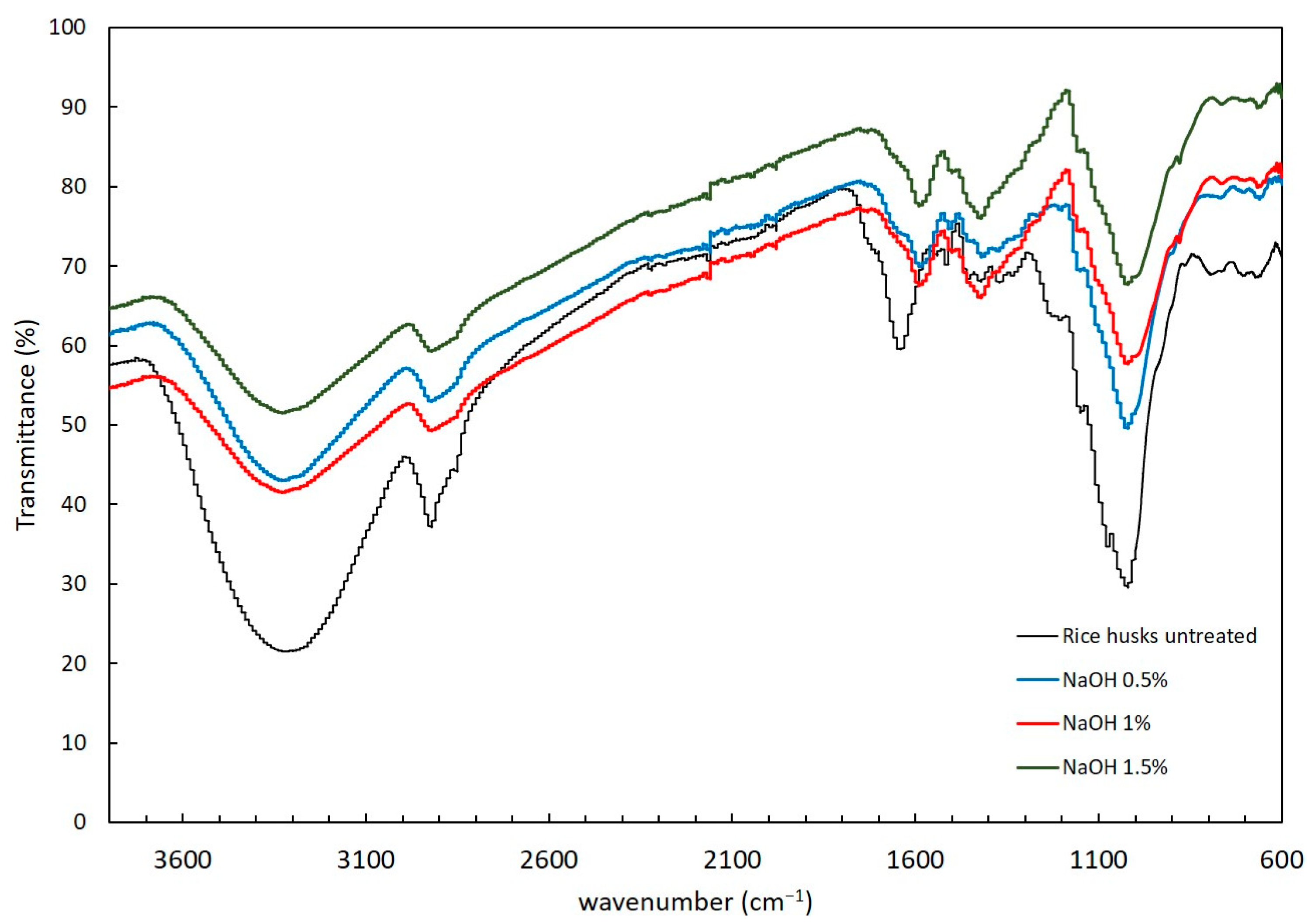
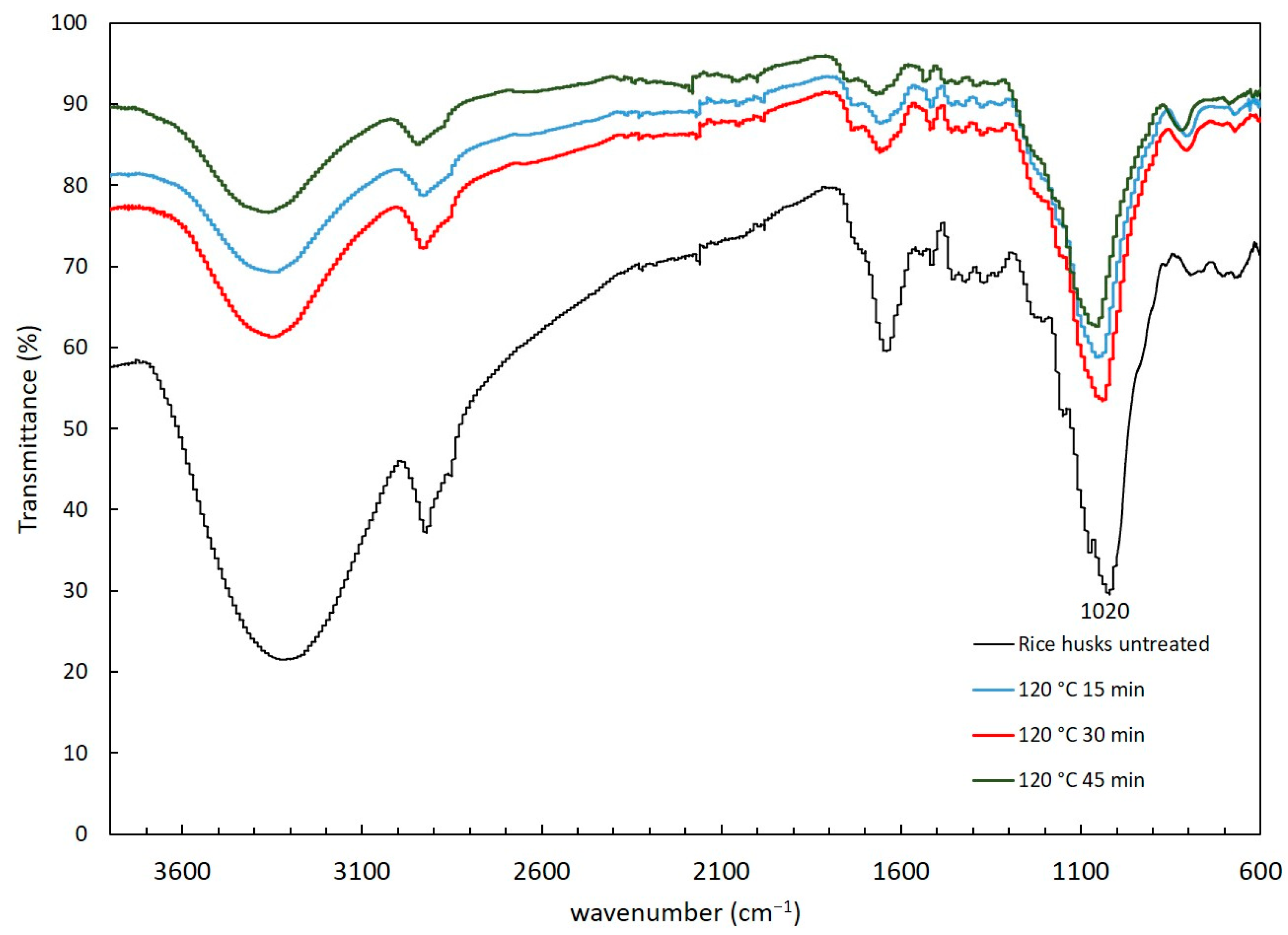
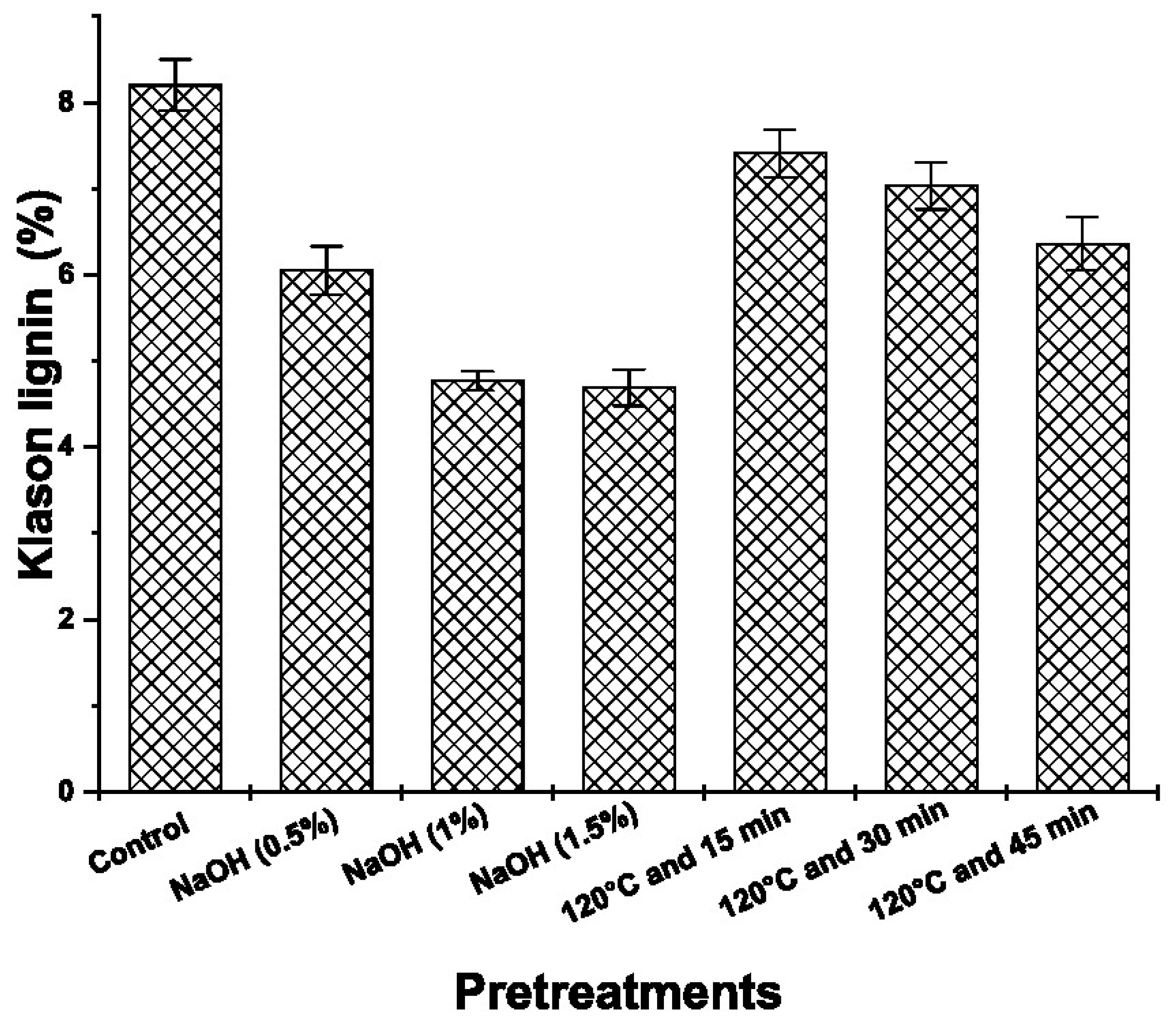
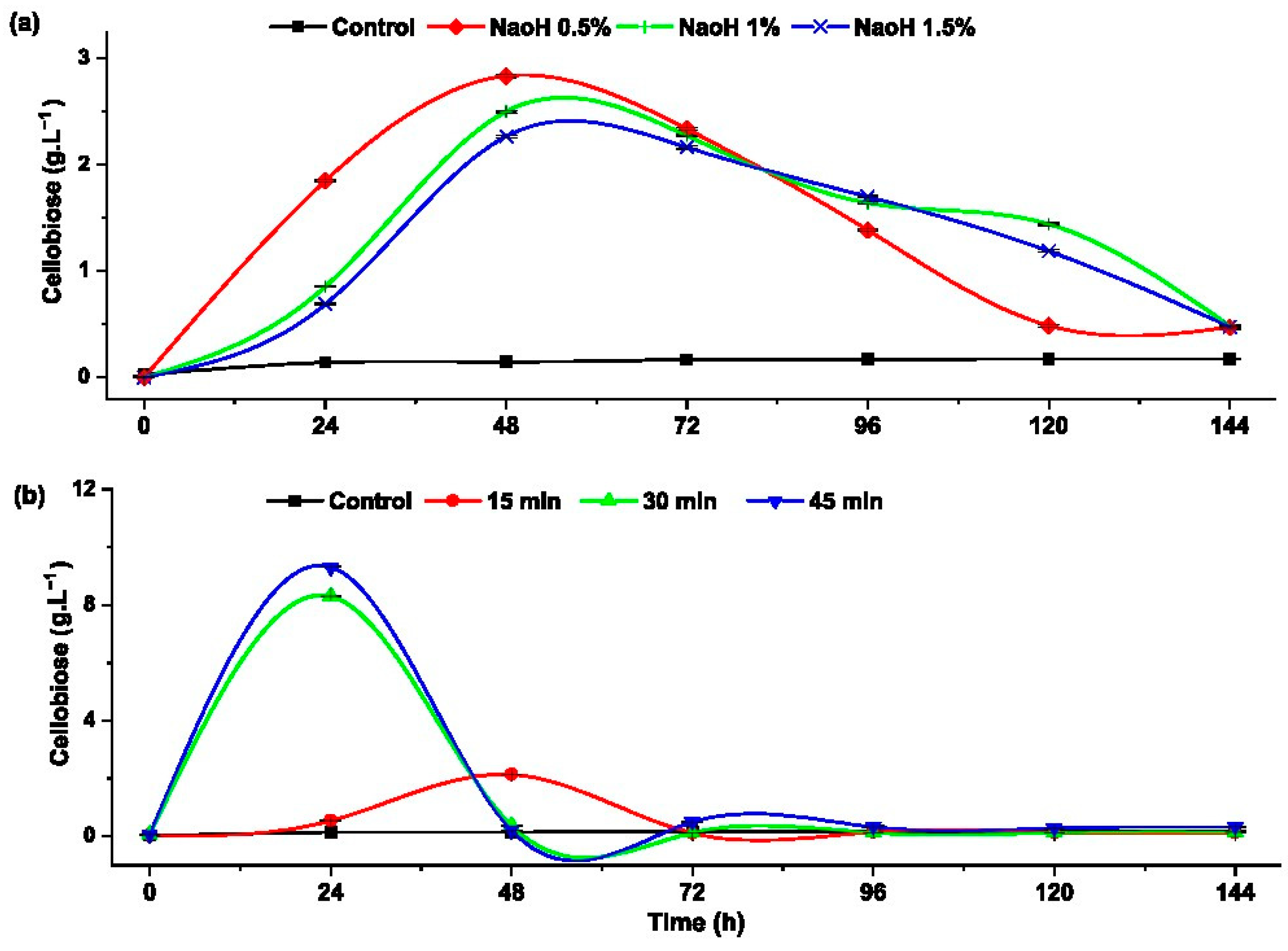
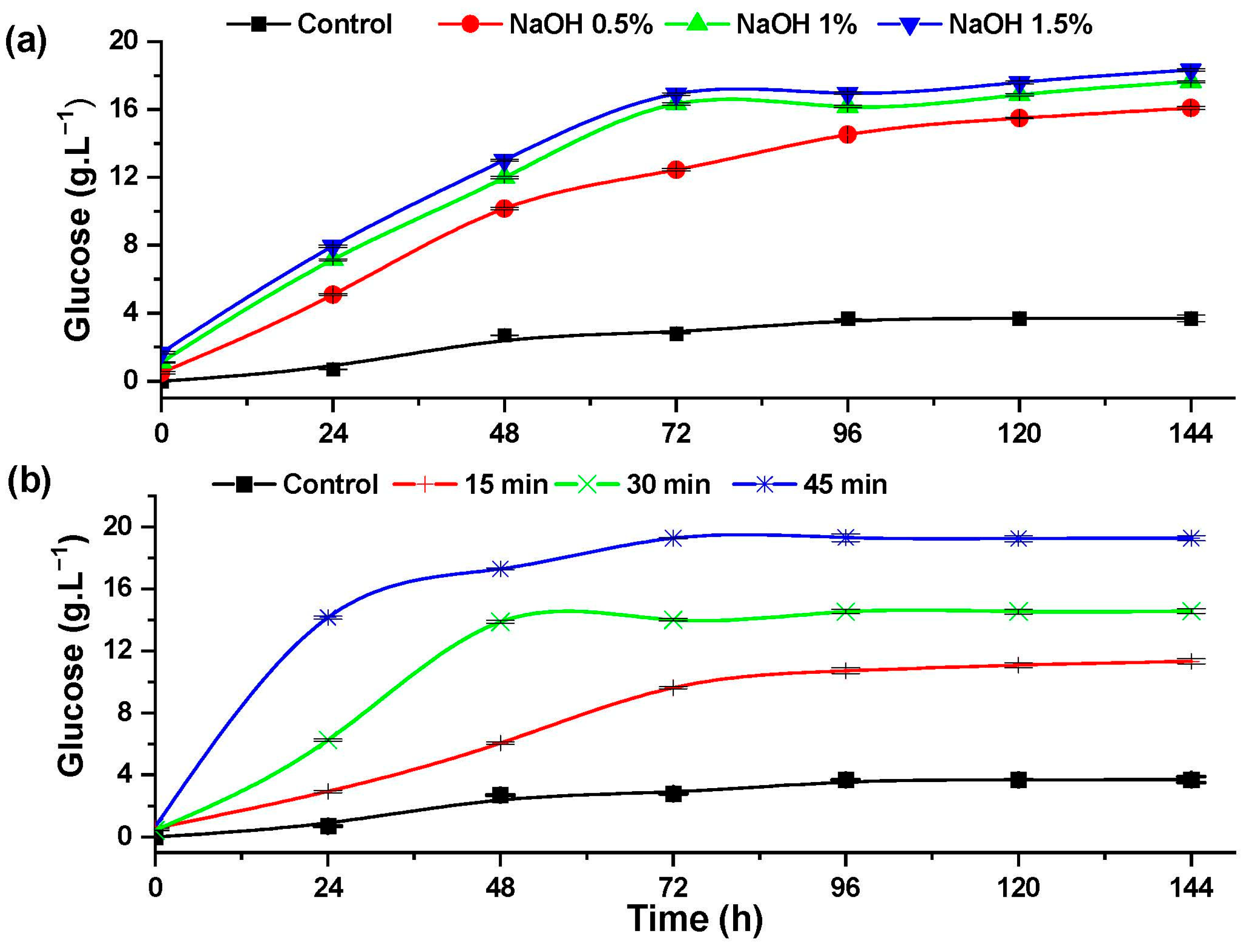
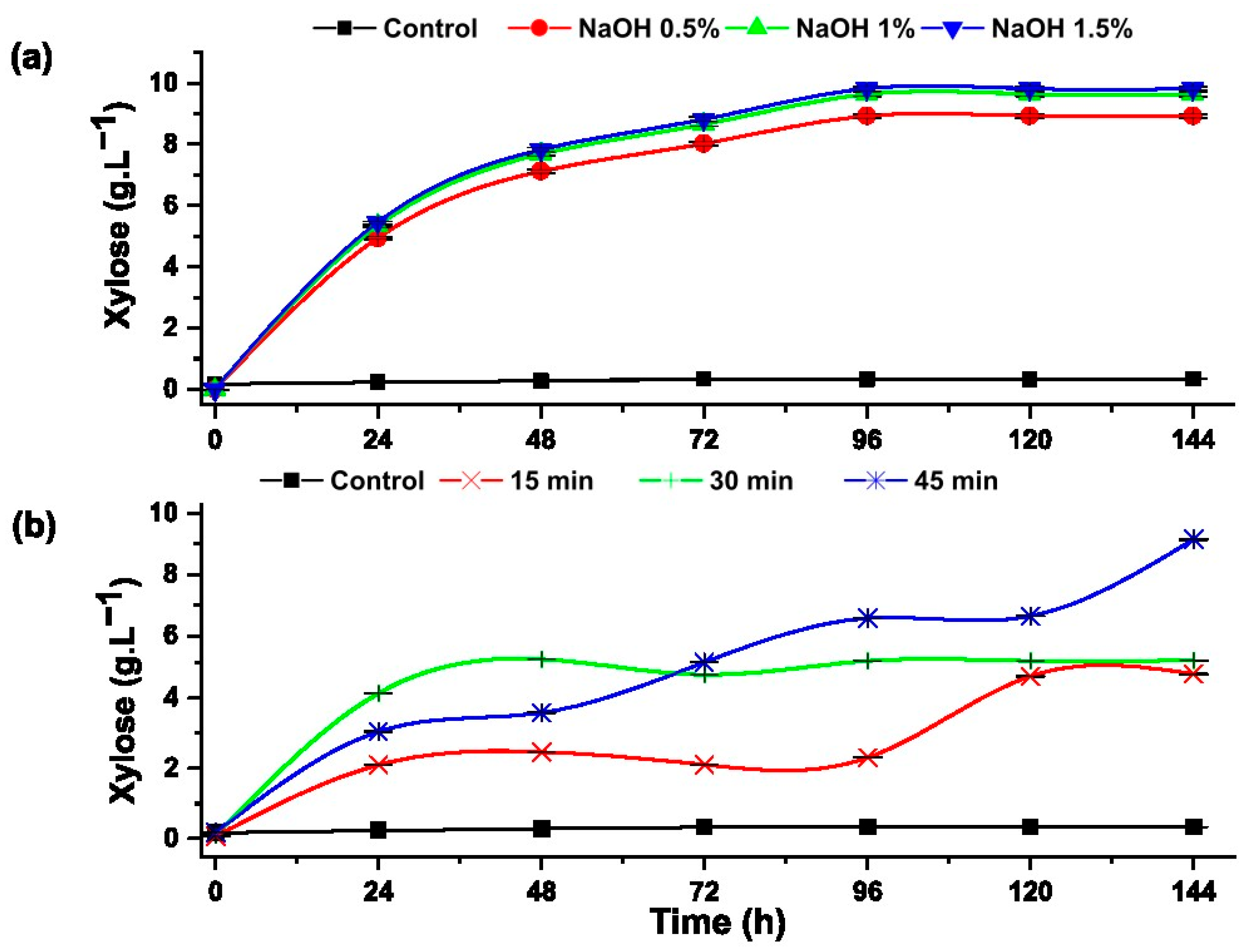

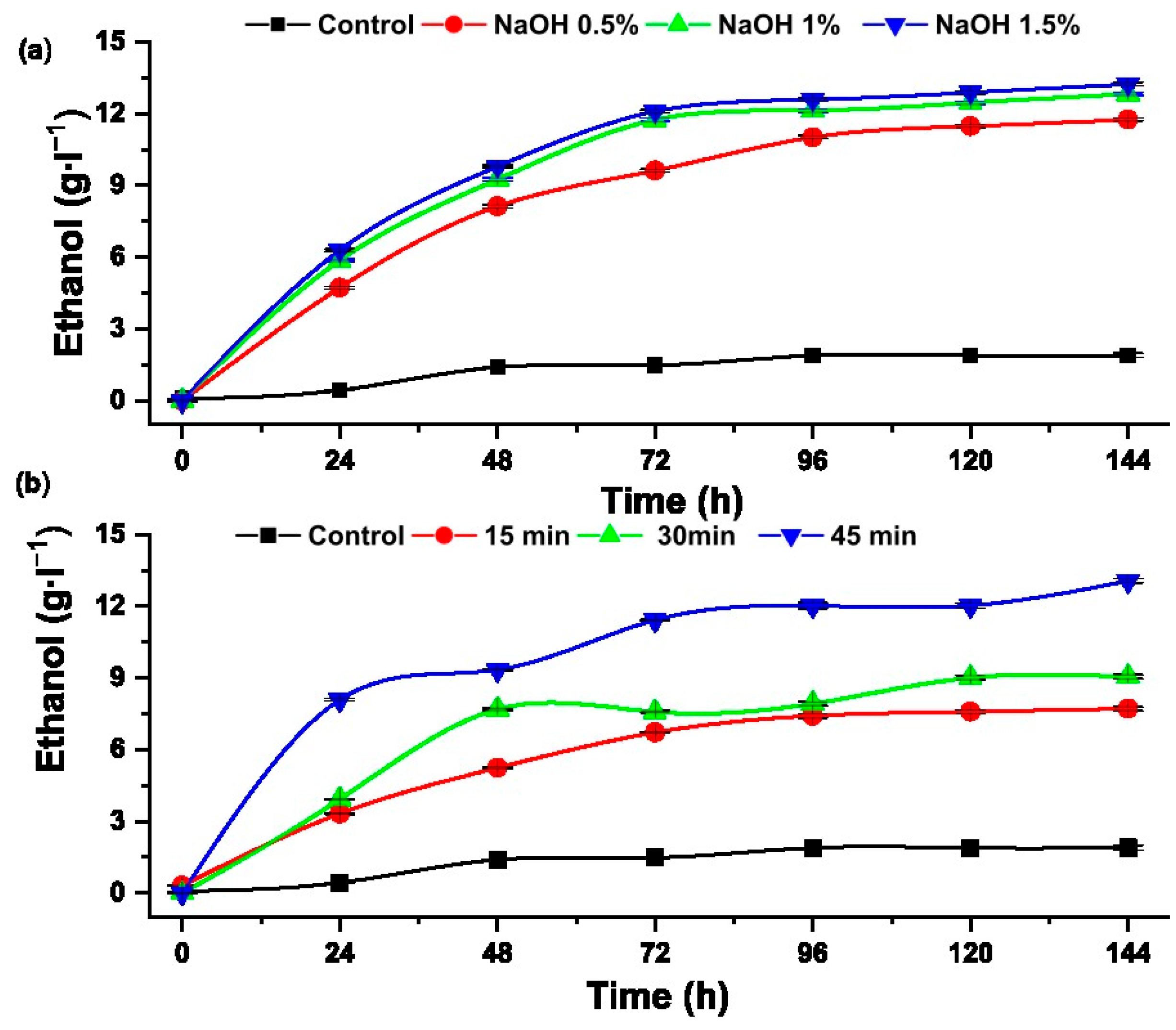

Disclaimer/Publisher’s Note: The statements, opinions and data contained in all publications are solely those of the individual author(s) and contributor(s) and not of MDPI and/or the editor(s). MDPI and/or the editor(s) disclaim responsibility for any injury to people or property resulting from any ideas, methods, instructions or products referred to in the content. |
© 2024 by the authors. Licensee MDPI, Basel, Switzerland. This article is an open access article distributed under the terms and conditions of the Creative Commons Attribution (CC BY) license (https://creativecommons.org/licenses/by/4.0/).
Share and Cite
Ayala-Armijos, J.; Lapo, B.; Beltrán, C.; Sigüenza, J.; Madrid, B.; Chérrez, E.; Bravo, V.; Sanmartín, D. Effect of Alkaline and Hydrothermal Pretreatments in Sugars and Ethanol Production from Rice Husk Waste. Resources 2024, 13, 128. https://doi.org/10.3390/resources13090128
Ayala-Armijos J, Lapo B, Beltrán C, Sigüenza J, Madrid B, Chérrez E, Bravo V, Sanmartín D. Effect of Alkaline and Hydrothermal Pretreatments in Sugars and Ethanol Production from Rice Husk Waste. Resources. 2024; 13(9):128. https://doi.org/10.3390/resources13090128
Chicago/Turabian StyleAyala-Armijos, José, Byron Lapo, Carolina Beltrán, Joaquín Sigüenza, Braulio Madrid, Estefanía Chérrez, Verónica Bravo, and Diana Sanmartín. 2024. "Effect of Alkaline and Hydrothermal Pretreatments in Sugars and Ethanol Production from Rice Husk Waste" Resources 13, no. 9: 128. https://doi.org/10.3390/resources13090128






